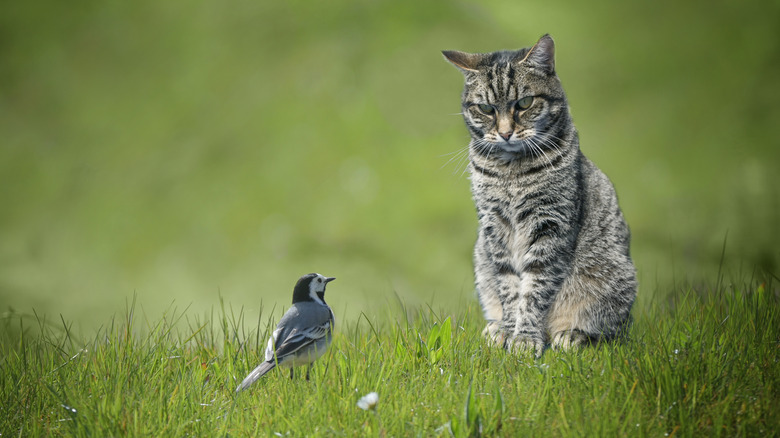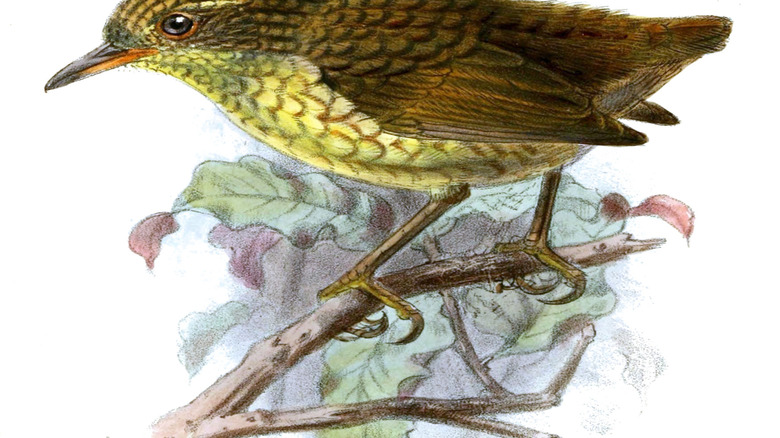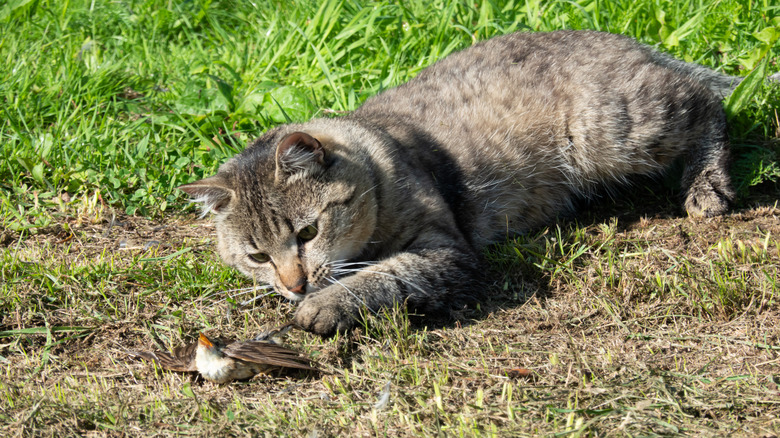One Cat Is All It Took To Make A Bird Species Extinct - And The Story Is Heartbreaking
While felines have become beloved family pets, with around 73.8 million in the United States alone, domestic cats don't always mix well with nature. Notably, scientists have observed that cats are among the most invasive species worldwide, having been attributed to the extinction of 63 species, according to a 2016 study by Deakin University. While it's hard to fault a feline for doing what comes naturally, one such case of extinction caused by a cat paints a heartbreaking story.
Located 55 miles south of the New Zealand coast, Stephens Island features mountainous terrain with peaks reaching nearly 1,000 feet across a quarter of a square mile of land. Here, the Lyall's wren, also known as the Stephens Island wren, thrived undisturbed by any major predators until the arrival of a seemingly harmless pet: Tibbles, a cat brought by lighthouse workers. It's believed that humans first set foot on the island in 1892, with its remote location allowing wildlife to thrive free of human interaction. The construction of a lighthouse and the eventual settlement of the island by workers, their families, and pets in 1894 was the beginning of the downfall of the Lyall's wren.
Tibbles would bring back birds to lighthouse worker David Lyall, who documented the findings of the birds due to his interest in ornithology. Lyall would then bring his findings to the mainland, where Walter Buller, New Zealand's leading ornithologist, confirmed it was a new species. However, a subsequent dispute over who had the right to claim the discovery of the bird allowed Tibbles' reign of terror to continue, resulting in the small flightless bird's numbers being decimated. While the popular narrative of the Lyall's wren's extinction suggests that a single cat was responsible, there are contradictory beliefs regarding what ultimately caused the tragedy.
Contradicting beliefs on the extinction of the Lyall's wren
While the image of Tibbles causing the extinction of a bird species is overwhelmingly tragic and heartbreaking, the legitimacy of the story has been questioned. It's not even known for sure where the cat was named Tibbles. According to some accounts, the case of Tibbles is believed to be incorrect, with the original story stemming from an essay titled "Extinct Birds" written in 1907 by Walter Rothschild, which overlooked conflicting information.
Even before people arrived on the island, the kiore, a rodent species resembling the adorable pet rat, likely contributed to the declining numbers. Moreover, other accounts attribute the population decline to "cats" plural, instead of a singular hunter. Later visits to the island revealed a large feline population, though whether these were the offspring of a single pet cat or several is unknown. The prevailing belief now is that the growing cat population led to the decline of the wren. With specimens of the wren found as late as 1899, the introduction of the first cat to the island was devastating but not necessarily cataclysmic as initially written about by Walter Rothschild.
Whether kept as a pet or as a feral or stray cat, a feline's hunting prowess is undeniably impressive. Are their hunting skills enough to pin the entire extinction of a species on a single cat? Unlikely, but the devastation of the Lyall's wren still serves as a cautionary tale for conservation and the responsibilities of cat owners toward their potential effects on the environment.
The importance of cat care in conservation
While the story of the Lyall's wren is a remarkable instance that could have been avoided with foresight and active efforts to prevent the introduction of an invasive species onto a previously uninhabited island, there are more modern cases that highlight the importance of monitoring cat behavior to aid conservation. In August 2019, Australian Geographic reported that a single cat had decimated an entire colony of fairy terns. The fairy tern is classified as a vulnerable species according to the International Union for Conservation of Nature's Red List. This incident proved devastating for the conservationists of the birds, who at the time issued a plea for people to keep their cats indoors in the area of the colony.
Recent cases should remind owners of the importance of not allowing their cats to roam freely and hunt. In Australia, cats are responsible for approximately 377 million bird deaths per year. In the U.S., the numbers are even higher, estimated to be between 1.4 and 4 billion annually. These alarming numbers should give pet parents reason to consider a cat as an indoor pet.
Not only do indoor cats have better health, but a well-cared-for in-house feline also cannot harm the ecosystem. No one wants their cat to be responsible for contributing to the extinction of another species. Those who love furred or feathered animals should do their part to ensure there is never another case like the heartbreaking story of the wrens on Stephens Island.


